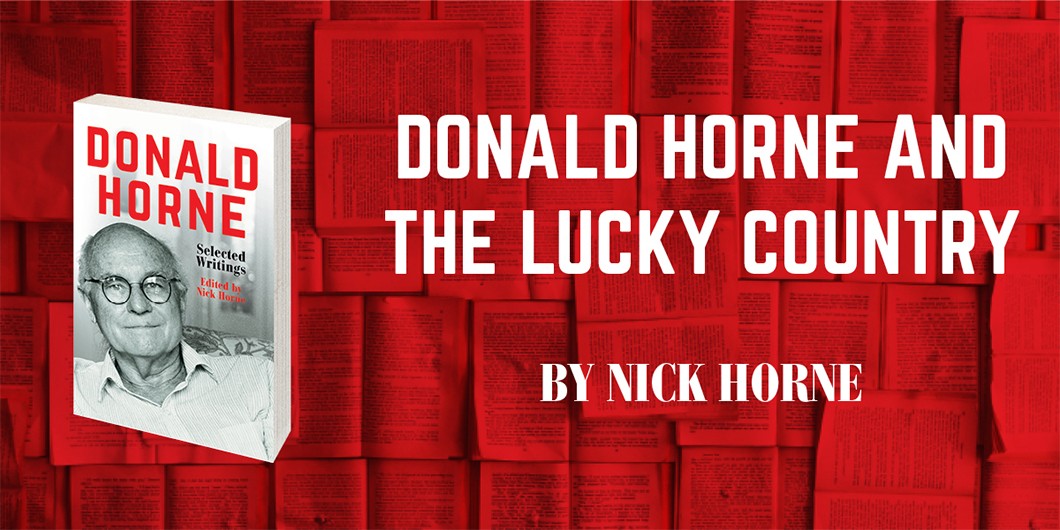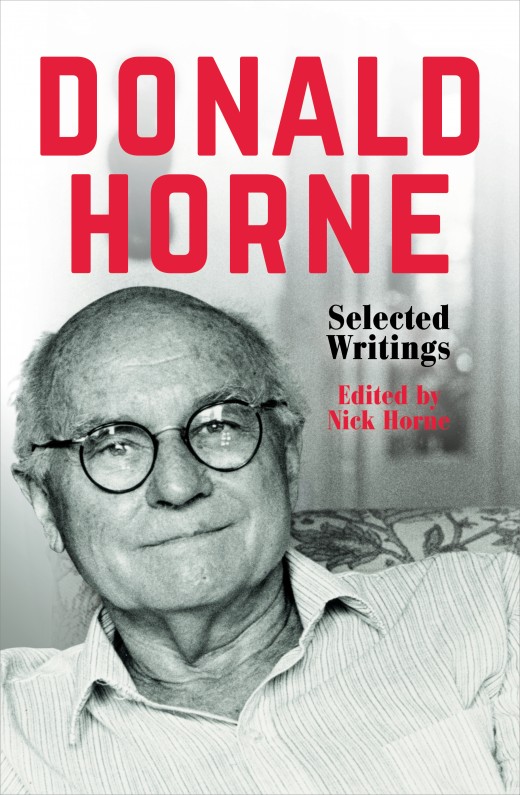News

News > News
Donald Horne and the Lucky Country
Nick Horne reflects on his father's most famous work: The Lucky Country.
When choosing pieces for Donald Horne: Selected Writings I flirted with the idea of not including a piece from The Lucky Country. That iconic book about the sixties is perhaps the best creative work of non-fiction written about Australia, but it’s still in print and my father wrote much other good stuff which deserves to get out of the shadows. Of the more than two dozen other books he wrote, half sold more than 10,000 (an unreliable but not a meaningless gauge). Would a selection from Handel’s Messiah be less compelling without the Hallelujah Chorus? (You could even enjoy the music without being forced to stand up.) Indeed, to leave the book out might have been a typically unconventional Horne-like thing to do: when working on a project to reproduce newspapers from the 1930s he chose Phar Lap’s failure to win the 1931 Melbourne Cup, rather than his win the previous year, as the sports story to report.
After about five minutes of flirting, I included two pieces from The Lucky Country. Several dozen out of several dozen obituarists surely can’t be wrong: Horne is remembered by his most famous book. My own experience points to the same conclusion with something like: ‘My father was Donald Horne.’ ‘Never heard of him.’ ‘He wrote The Lucky Country’. ‘Oh, Donald Horne’. More than just an author’s most famous book that is still readable today, The Lucky Country has become part of the country’s vernacular.
To describe Horne, in shorthand, as the author of The Lucky Country is a fair enough starting point, but he had an uneasy relationship with the phrase itself, ostensibly because of its misuse. ‘I wish I’d never invented the fucking thing!’ he said on one occasion. Its misuse has become a truism with common references to what I think of as the oft-quoted “oft-quoted but often misunderstood phrase”.
Horne invented it (in its ironic construction) in a late draft of the last chapter, which had been called ‘THE NEW AUSTRALIA: More By Good Luck’. The old chapter heading is crossed out and replaced, in uncharacteristically legible hand writing, with the now famous phrase. In a letter to Penguin publisher, Geoff Dutton, in which he agrees with Dutton’s suggestion that the title of the last chapter should be given to the book, Horne wrote: ‘Oddly enough, I gave this title to the last chapter with the idea that it might make a title for the whole thing. Somehow it slipped off the list.’ He goes on to say that it ‘sums the whole thing up’.
And yet the phrase doesn’t really sum the whole thing up. The UK Penguin office didn’t think so, and the UK edition went under the title of Australia in the Sixties. In a long 1994 interview Horne described The Lucky Country as a ‘series of essays’ which ‘had no theme at all’. In a preface to the second edition he wrote ‘The central concern of the book is a general description of Australia. The ‘lucky country’ theme is really a subplot.’ Further, when he wrote The Lucky Country he was working in advertising (the book’s generally balanced tone might owe something to this fact) and he might have seen the phrase’s marketing potential. My guess is that it not so much ‘slipped off the list’ as was stowed out of temptation’s way.
Just as The Lucky Country title might have been problematic, Albert Tucker’s ruggedly beautiful ‘explorer’s head’ probably wasn’t an appropriate cover for the forward looking book. Reminiscent of the northern part of Australia, put on its side, that Leichhardt explored, it represented an Australia that was, as Horne described it, ‘immovable, brutal and dried out.’ But as with the title, so with the cover – it proved to be so popular that people stole the cards bearing its image that were used in bookshops as part of Penguin’s promotion campaign.
After completing the book, Horne further developed his ‘lucky country thesis’, which gets its best explanation in the introduction to a 1998 edition of the book (although the book itself was not significantly revised after 1971). The three prongs of the thesis were that Australia needed a greater engagement with the countries that make up Asia; improved economic management depended on the abandonment of a colonial-minded and derivative business culture; and we needed to develop a new, independent self-definition that matched the reality and the potential of the place. Even if you don’t think luck has been a major theme of Australian successes, you could still acknowledge the validity of the calls for the need for improvement in the lucky country thesis, in the sense that sometimes ‘you need to change to stay the same’.
The lucky country thesis evolved as Horne evolved (from an idiosyncratic conservative to a sceptical but optimistic progressive). In the first edition of The Lucky Country, of the ‘two fields where reliance on luck and last-minute adjustment are not going to work’, a factor in the first, Australia’s proximity to Asia, was a Cold War fear of communism – Horne lamented that we were ‘near the bottom of the list in per capita defence expenditure.’ Indeed, Horne supported Australian involvement in the Vietnam War, until 1968. As the fear of invasion receded, the issue of our proximity to Asia became more a question of untapped potentialities.
The other field in which Australia could not rely on luck, ‘reactions to the demands of technology’, was primarily a question of economic management. It was a criticism of a derivative business culture and an inept political leadership that wouldn’t maintain Australia’s position on the per capita national income scale. This part of the thesis also evolved as Horne became disenchanted with a narrow attachment to economic orthodoxy (that, in the seventies, wasn’t working), to the effect that Horne emphasised the broad benefits to be gained from a more innovative and self-confident culture.
The Lucky Country was written as a snapshot of the sixties with a projected shelf life of probably a few years, and its longevity presented problems. Motivated by the changing nature of Australia in the second half of the sixties (in particular the mining boom) and by research for a work of history that became The Australian People, Horne’s general thinking developed, and he wrote substantial revisions for The Lucky Country in 1970. Penguin sensibly felt they were already on a good thing and Horne’s revisions became an entirely new book, The Next Australia. He wasn’t especially proud of this book (he could be quite self-critical), but it was an important work in Horne’s political evolution: he wrote the book as an unenthusiastic supporter of the Liberal Prime Minister of the day, John Gorton, and read its reviews realising that, in fact, he might be a qualified supporter of Labor Opposition Leader Gough Whitlam.
A new, slightly revised edition of The Lucky Country came out in 1971 and there were more than half a dozen reprints by the time of Australia’s Bicentenary in 1988. By this date, Horne’s thinking had evolved in a more elaborately systematic way, although he was still able to speak the language of intelligent superficiality (which, as Horne said, itself is a kind of system). The Great Museum (1984) and The Public Culture (1986) represented a real change of focus for Horne, both in their non-Australian subject matter, and in their attempt at developing an elaborate but intelligible theoretical framework for the understanding of a society.
Armed with this new theoretical framework he wrote Ideas for a Nation in 1989 which examined Australia’s ‘public culture’, an idea which owed a bit to Gramsci’s idea of hegemony (shorn of its attempt to explain why the working class hadn’t been more revolutionary). At this time he was pretty much prepared to throw The Lucky Country overboard (which probably owed more to the desire not to be fatuously asked if Australia was still the lucky country, than anything else) describing Ideas for a Nation as ‘an affectionate adieu to The Lucky Country’.
‘Adieu’ became ‘au revoir’ when Penguin brought out the new edition of The Lucky Country in 1998, with a cover that replaced the sub-title, ‘The Classic Study of Australia in the Sixties’ with ‘The classic book that explains Australia today’. Only Donald Horne experts would remember Ideas for a Nation; The Lucky Country is still in print. And now, more than a decade after Donald Horne’s death, his most famous book takes its place in a selection of pieces from this most intelligent and organic of Australian writers. Donald Horne: Selected Writings comes out on the fiftieth anniversary of the publication of Horne’s autobiography, The Education of Young Donald, which also features prominently in the selection. Indeed, The Lucky Country, with its understanding of an older Australia that, in a changing world, needed to change to stay ahead, could only have been written by someone who had lived the life described in The Education of Young Donald.
Share this post
About the author
Donald Horne was the author of The Lucky Country and The Education of Young Donald, and many other books and essays. A leading public intellectual for close to fifty years, he edited the Bulletin, chaired the Australia Council, and pioneered cultural studies at the University of New South Wales.
More about Donald Horne



